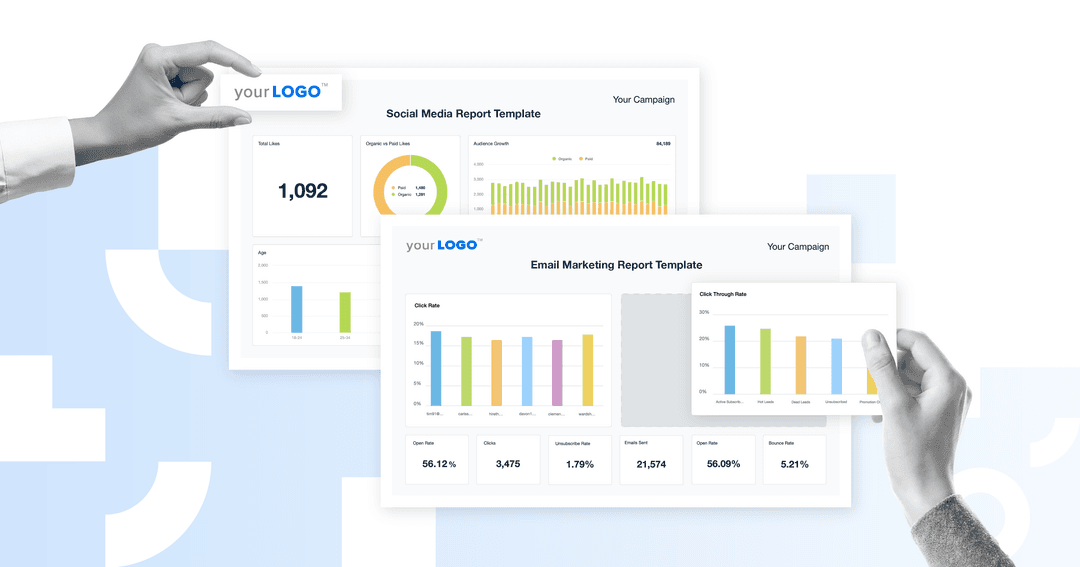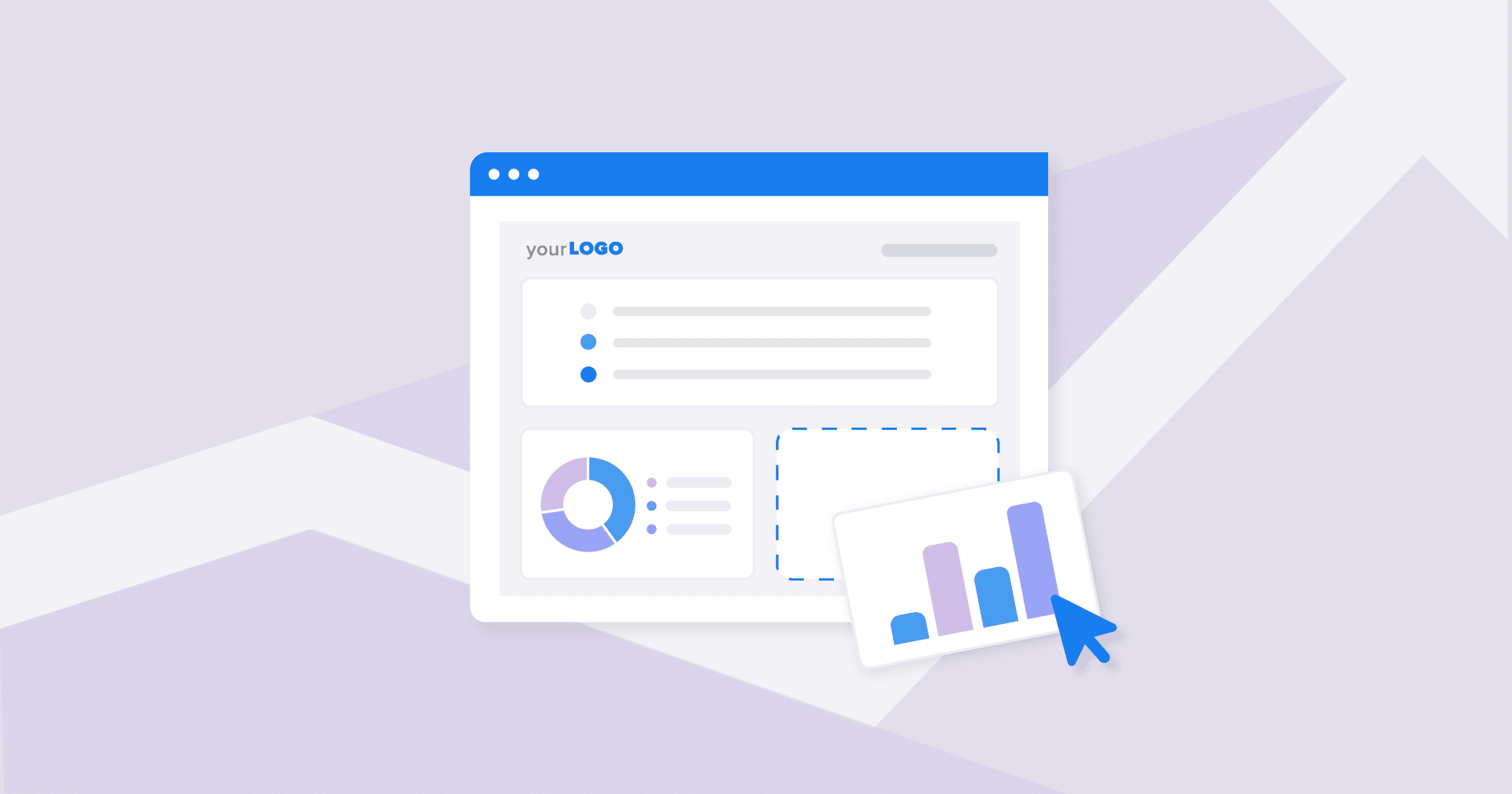Table of Contents
Table of Contents
- What is a marketing report?
- 3 reasons why you absolutely need a marketing report
- How often should you create a marketing report?
- 8 must-have marketing report examples and templates for smarter decisions
- How to present client marketing data
- How to build marketing dashboards that support your internal strategy AND client reporting
- Why use AgencyAnalytics for client reporting?
- It’s time to automate marketing reporting
7,000+ agencies have ditched manual reports. You can too.
Free 14-Day TrialQUICK SUMMARY:
Is your marketing team overwhelmed by data and looming client report deadlines? This post shares a list of 8 marketing report examples and templates to help you streamline reporting and focus more time on insights and marketing strategy.
We’ve all been there—a client meeting is around the corner, and you're knee-deep in spreadsheets, screenshots, and scattered data from half a dozen platforms. You're trying to piece together a report that’s clear, insightful, and that makes sense. Before you know it, it’s already midnight.
Sound familiar?
For growing agencies, that last-minute scramble is all too common. But it doesn’t have to be!
That’s where marketing report templates make all the difference. Rather than building each report from the ground up, templates give you a ready-made structure.
The biggest benefit? Time savings.
Templates eliminate repetitive work, reduce manual errors, and help you create polished, client-ready reports in minutes—not hours.
But it's not just about winning that time back, it's about what you can do with it!
Winning back time allows the team to focus less on doing admin tasks, and focus on client campaigns. Saving this time has been massive for us, as no one is wasting all those hours on reporting anymore.


In this post, we’ve rounded up eight marketing report templates to help you skip the chaos and get straight to the strategy. Bookmark them so you never have to start from scratch!
What is a marketing report?
If you’ve ever found yourself explaining campaign performance on the fly, you already know why marketing reports matter.
They take all your agency's behind-the-scenes work and turn it into a clear story your clients can follow. Instead of dumping marketing metrics in a document, they highlight what matters—like how many visitors became leads, how much those leads cost, and whether your marketing strategy is driving real results.
The best reports don’t just show wins. They foster transparency. They make space for honest conversations about your marketing efforts and drive smarter decisions.
And when you send reports regularly, they become a quiet but powerful reminder of your agency’s value—month after month.
3 reasons why you absolutely need a marketing report
If your marketing team runs advertising campaigns without regular reports, you’re missing out. Here’s why a structured marketing report is essential for agencies and clients alike:
1. Measure and improve marketing performance
Marketing decisions shouldn’t be based on guesswork; they should always be grounded in data.
A well-structured report helps you track Key Performance Indicators (KPIs) like organic traffic, conversion rates, and ad spend, so you know exactly what’s working and where there’s room to improve. Reviewing these metrics regularly is how you uncover insights and refine your marketing efforts and content marketing strategies.
2. Keep clients informed
Reporting is more than a formality; it’s how you prove your value and build lasting trust. A strong marketing report shows the real impact of your strategy by highlighting key data points like SEO rankings, social engagement, and paid ad performance.
When clients see how their investment is paying off, it builds confidence and opens the door to deeper collaboration. Well-crafted reports turn raw data into compelling stories that keep clients engaged and aligned.
Related read: How To Tell a Powerful Story With Client Data
3. Make data-driven decisions faster
Without a clear view of your performance, it’s easy to overspend your marketing budget on what’s not working. That’s where marketing reports come in. By consolidating data from tools like Google Analytics, social platforms, and email marketing software, you get a single source of truth that’s easy to scan and act on.
Reports with data visualizations make it simple to spot trends, fine-tune marketing campaigns, and reallocate your marketing budget where it matters most.
Our clients are busy and don't understand marketing, so having key metrics they can see that relate to business growth is key to making their lives easier and allowing them to make good decisions quickly.
Lane Rizzardini, Co-Owner, Marion Relationship Marketing
How often should you create a marketing report?
Now that you know why reporting matters, the next question is how often you should be doing it.
Picking the right reporting schedule is all about balance. Some clients might want frequent updates, while others are happy with a monthly check-in. The goal is to keep them in the loop without overwhelming either side with too much back and forth.
The power of the monthly marketing report
43% of marketing agencies have clients on a monthly retainer, which means they expect to see a report before their next payment.
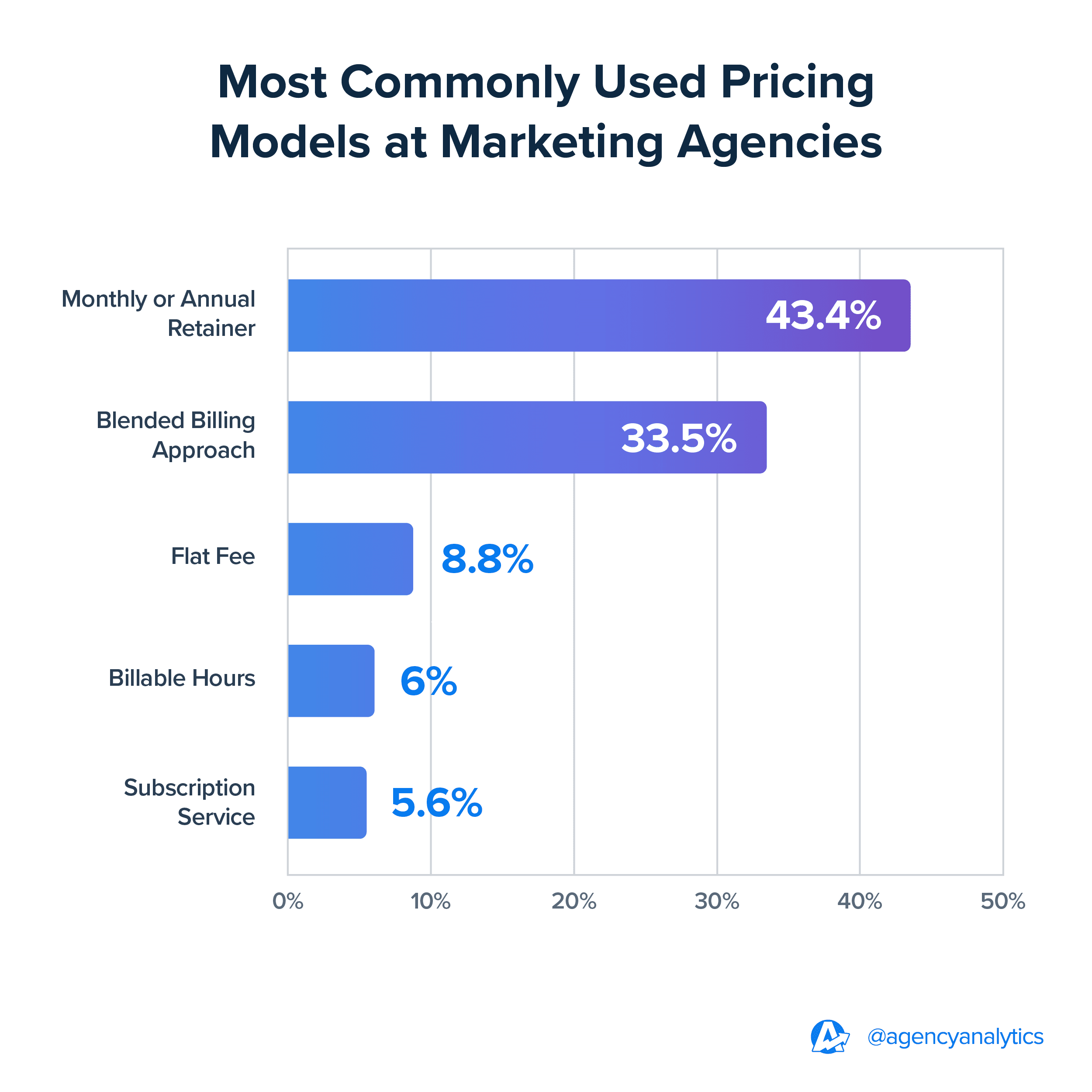
Monthly marketing reports help you do exactly that. They show your progress, the impact of your efforts, and the value your agency brings to the table. Monthly marketing reports are one of the simplest, most effective ways to keep clients engaged and build long-term trust.
Plus, reviewing performance every month allows you to zoom out and spot bigger-picture trends, whether steady organic growth, shifts in PPC performance, or changes in social engagement. That broader view makes it easier to fine-tune your marketing strategy before the next billing cycle.
Be careful with weekly marketing reports
Weekly marketing reports might sound like a good way to keep clients in the loop—but in most cases, they’re better suited for high-value enterprise clients with complex needs.
For small to mid-sized clients, weekly updates packed with too much information can do more harm than good. Quick weekly summary updates are great, but frequent reports often lead to micromanagement, where clients start zeroing in on every slight dip in performance and expect quick fixes. That kind of dynamic can quickly turn a regular client into a high-maintenance one.
For most clients, monthly reports and weekly summaries are the sweet spot. They keep communication consistent while giving enough time to gather meaningful results. If a client wants more visibility between reports, set them up with a real-time dashboard so they can check in anytime without extra hand-holding.
Impress clients and save hours with custom, automated reporting.
Join 7,000+ agencies that create reports in under 30 minutes per client using AgencyAnalytics. Get started for free. No credit card required.
8 must-have marketing report examples and templates for smarter decisions
Now that you’ve seen the templates, here’s the different report types and how to bring the data to life for your clients.
When juggling multiple clients and campaigns, having the right report template makes all the difference. These eight examples are designed to help you present marketing metrics and insights, save time, and drive better marketing decisions. Bookmark this list so you’re never starting from scratch!
1. General marketing report example — best for high-level performance overviews
Let’s start with the one most agencies rely on. A general marketing report is your all-in-one performance snapshot. It combines key metrics across all marketing channels—email, SEO, PPC, social, and more—so your clients can see how everything connects to broader business goals. This template is especially helpful for high-level overviews or executive stakeholders who want the big picture at a glance.
Key marketing metrics to include in a general marketing report:
Lead & Conversion Metrics
Total leads by channel (SEO, PPC, email, social media, referrals, offline sources, etc.)
Paid vs. organic lead breakdown
Cost per lead (CPL) or cost per conversion by paid channel (Google Ads, Facebook Ads, Bing Ads, etc.)
Revenue generated by channel
Traffic & Engagement Metrics
Website sessions by source and device
Percentage of new sessions
Top-performing pages
Top referral sources
SEO Overview
Keyword rankings and changes
SEO site health score
Backlink acquisition and quality
PPC Overview
Social Media Overview
Traffic from social platforms
Engagement rate (likes, comments, shares, saves)
Follower growth rate
Agency Tip: Use this template to tell a story. Start with a summary of wins and challenges, then break down metrics by channel so clients can see how each area performs and how it contributes to overall ROI.
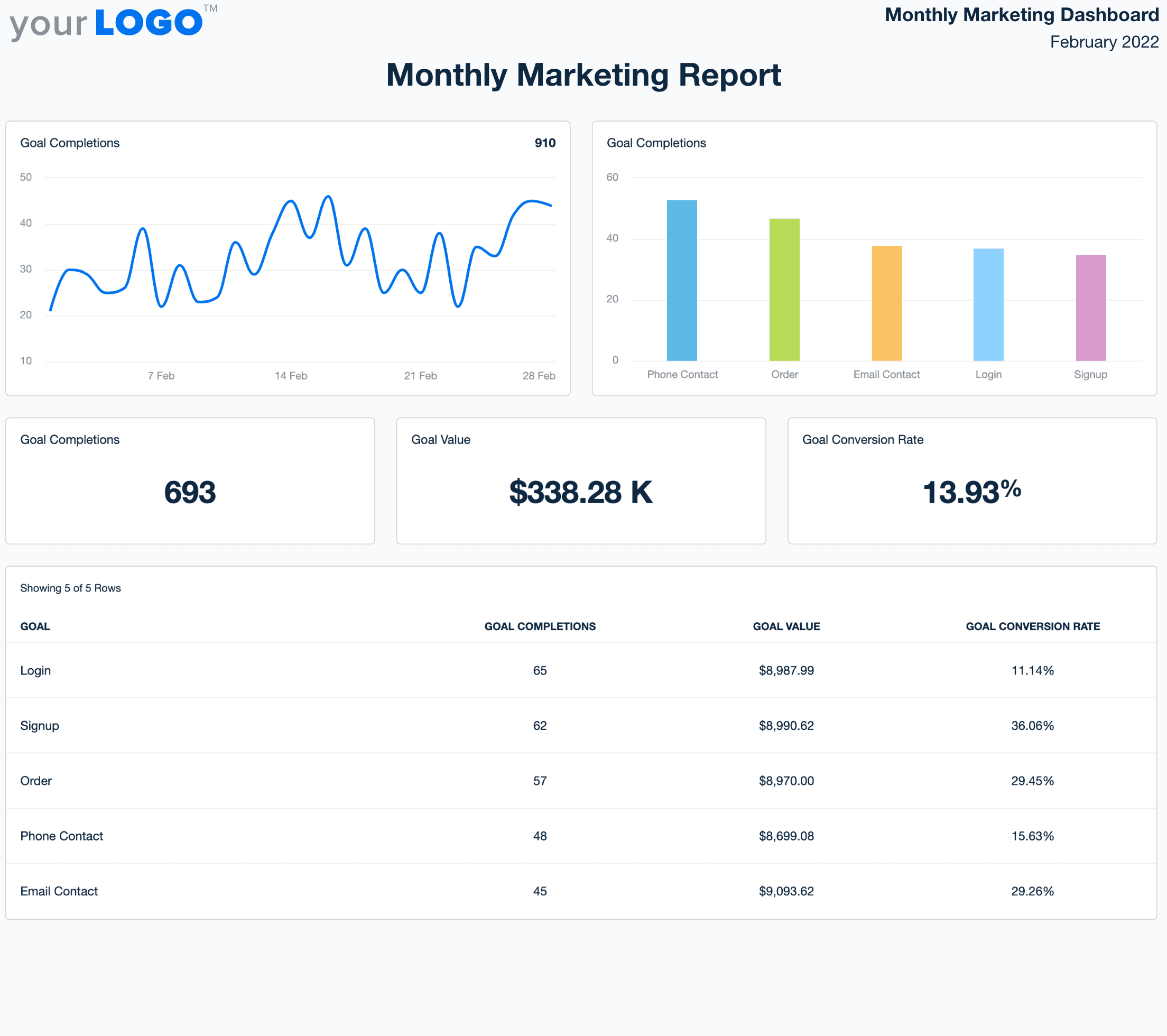
2. Digital marketing report example — best for tracking all online marketing efforts
For digital-first campaigns, this one’s a must. A digital marketing report is your go-to template for tracking all online marketing efforts, both paid and organic. It’s perfect for showing how different digital tactics work together to support client growth.
Key metrics to include in a digital marketing report:
Whether you're tracking SEO, PPC, social, or content marketing efforts, make sure to include performance indicators like:
Website Performance
Sessions
Goal completions/conversion rate
Top landing pages
SEO Metrics
Organic sessions
Keyword rankings
Backlink count
SEO site health score
Domain authority
PPC Metrics
Clicks
CTR
CPC
Conversions
ROAS
Social Media Metrics
Total followers
Engagement rate
Follower growth
Post impressions / reach
Website traffic from social
Email Marketing Metrics
Open rate
CTR
Unsubscribe rate
Email conversions
Revenue from email
Channel Comparison Overview
Traffic by channel (organic, paid, direct, referral, email, social)
Leads or conversions by channel
Revenue by channel
Agency Tip: Divide your report into sections (SEO, PPC, email, social) so clients can easily digest the data.
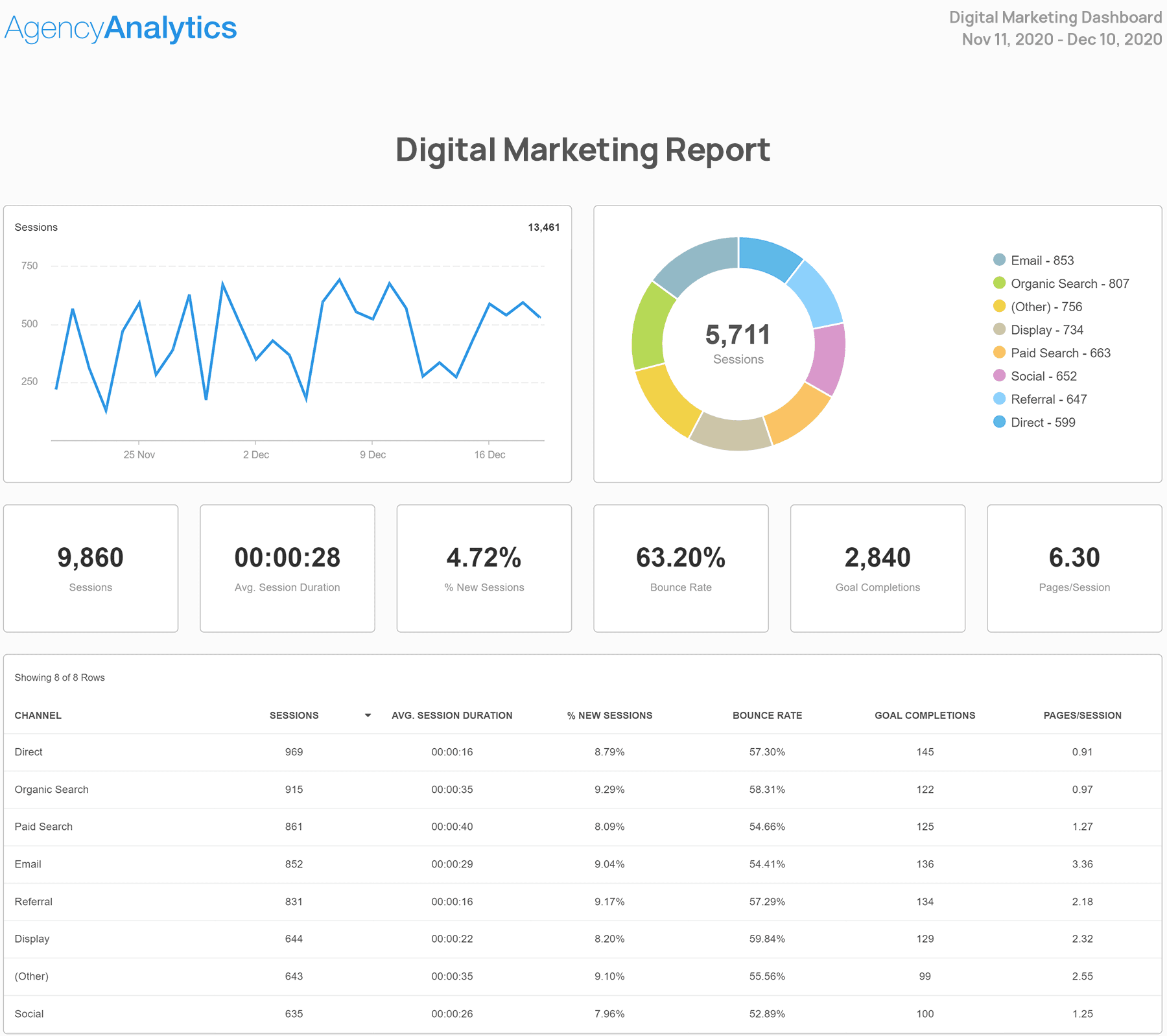
3. Social media marketing report example — best for analyzing engagement across social platforms
A social media marketing report helps you demonstrate how social campaigns drive real engagement, build awareness, and support broader marketing goals. It’s ideal for showing both organic and paid social performance in a way that’s easy to understand.
Key metrics to include in a social media marketing report:
Audience Growth
Follower growth rate
Follows vs. unfollows
Organic VS paid likes
Engagement Metrics
Total engagements (likes, comments, shares, mentions, saves, clicks)
Top-performing posts
Average engagement per post
Reach & Impressions
Video watch time
Reach by platform
Traffic & Conversions
CTR on social posts
Social referral traffic to website
Leads or conversions from social
Landing page visits from social
Goal completions from social traffic
Agency Tip: Separate organic and paid performance to show the full picture. Highlight top-performing content, then offer actionable insights—like what type of posts resonate most.
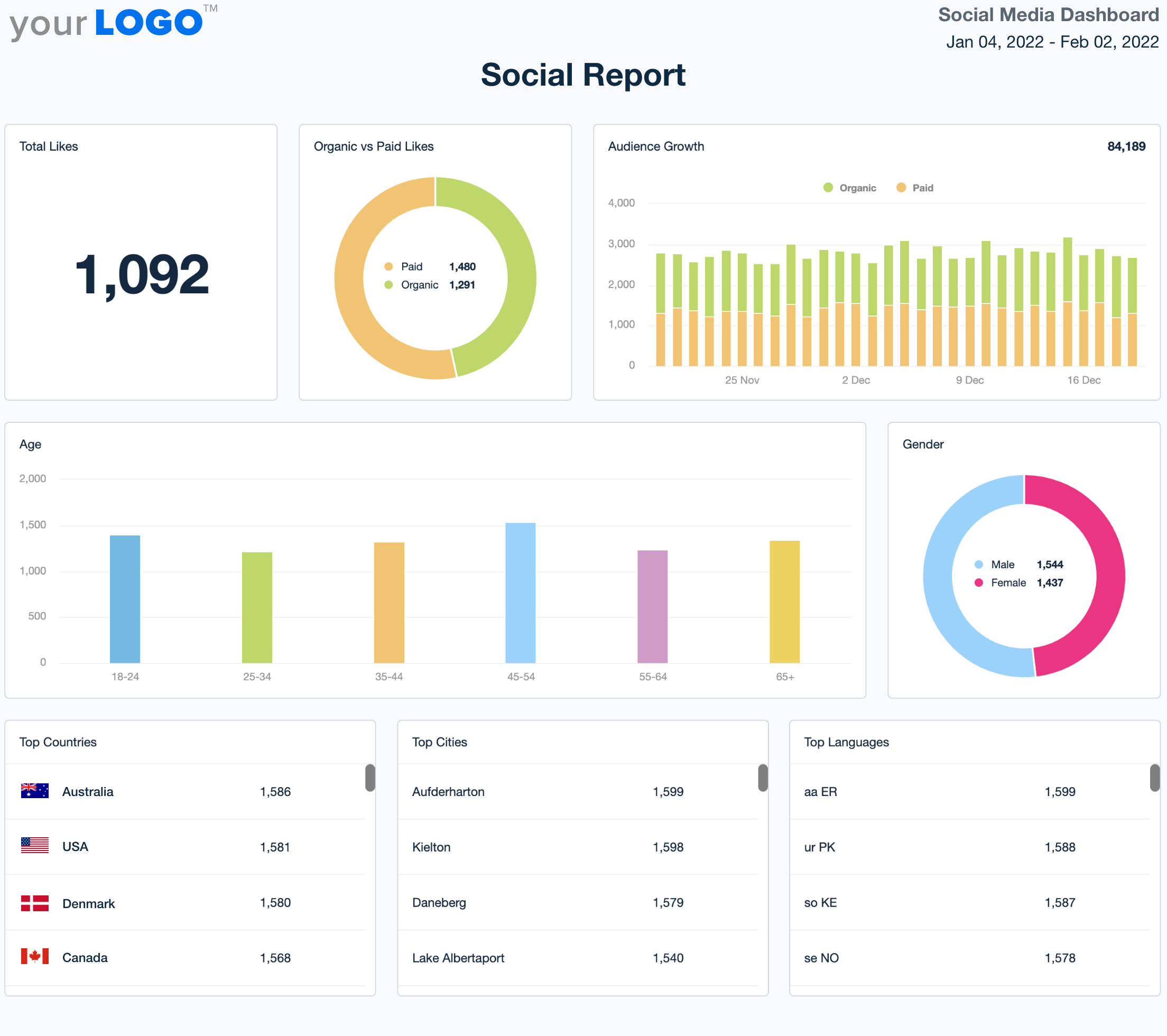
4. SEO report example — best for showcasing organic growth
An SEO marketing report goes beyond keyword rankings—it shows how your efforts drive organic visibility, improve user behavior, and contribute to conversions. This is a must-have for clients investing in long-term search strategies.
Key metrics to include in an SEO report:
Sessions
Bounce rate
Average SERP position
CTR
Agency Tip: Include a summary of major keyword wins and monthly technical improvements. Within AgencyAnalytics, use the Ask AI feature to surface these insights in a fraction of the time!
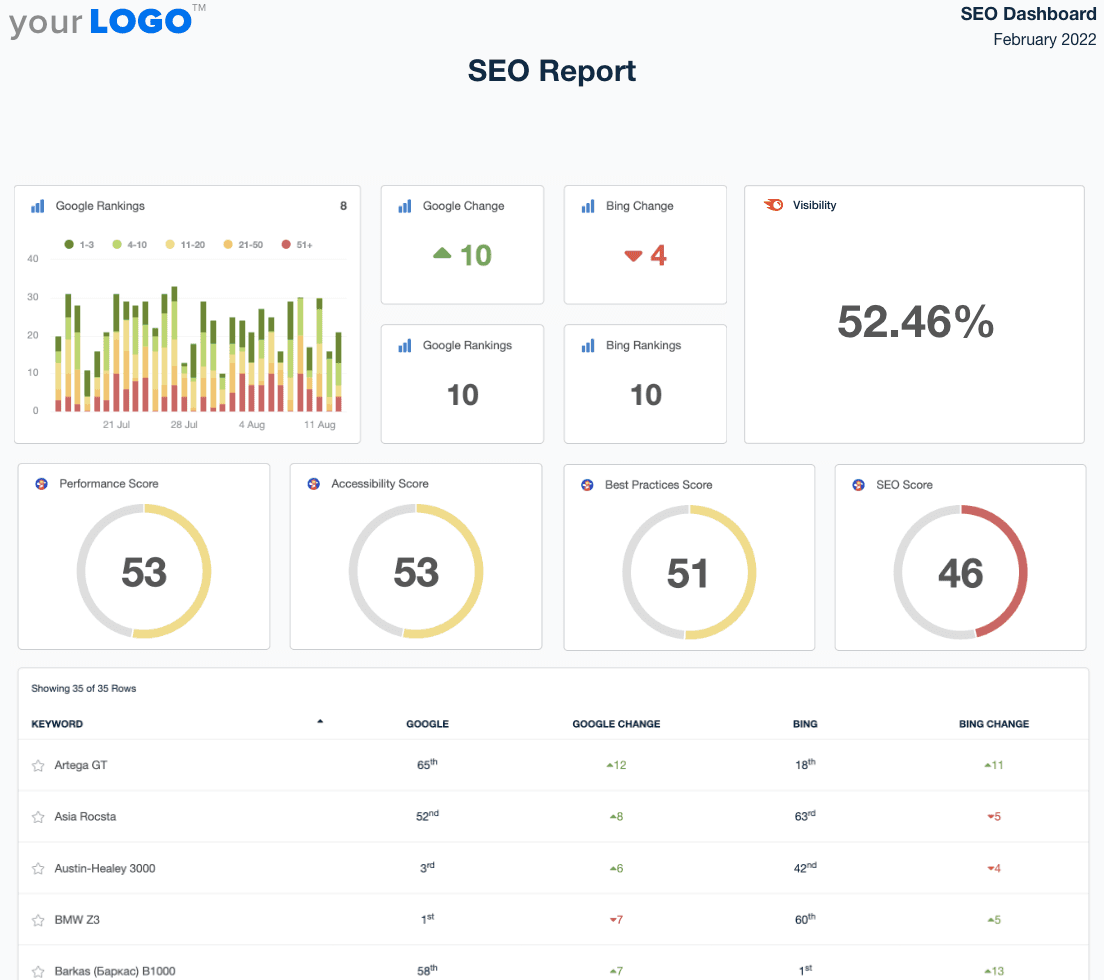
5. PPC report example — best for evaluating paid campaign performance
PPC clients want to know one thing: are their ads paying off? A PPC report delivers a clear view of performance for PPC campaigns, ad spend, and ROI. Whether you’re managing Google Ads, Bing, or social PPC, a PPC marketing report gives you the structure to show impact and identify opportunities.
Important metrics to include in a PPC marketing report:
Campaign Performance
Impressions
Clicks
CTR
Average ad position
Cost & Efficiency Metrics
Cost per conversion
Conversion rate
Conversions & Revenue
Total conversions
Conversion value
ROAS
Leads or sales generated
Ad Engagement
Ad engagement rate (CTR + interactions)
Top-performing ads
Ad relevance score
Call or form fills from ads
Mobile vs. desktop ad performance
Channel & Campaign Breakdown
Performance by platform (Google Ads, Bing, Facebook, etc.)
Campaign-level performance (e.g., Search vs. Display)
Ad group performance
Keyword performance (CTR, conversions, CPC)
Geographic performance
Agency Tip: Segment PPC campaigns by goal, such as brand awareness, lead generation, or conversions, and pair spend data with performance to show value.
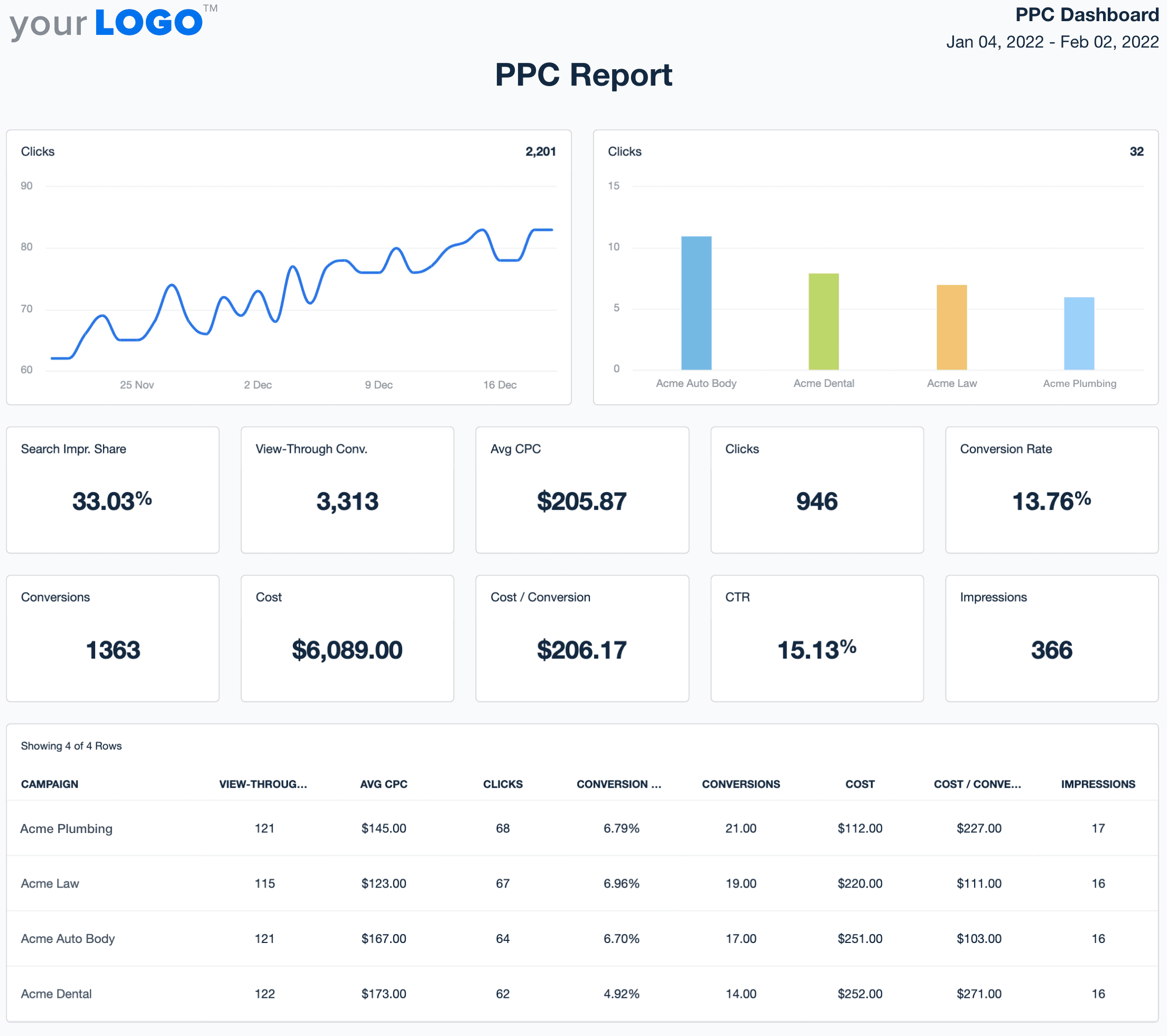
6. Email marketing report example — best for monitoring email engagement and conversions
Email still delivers one of the best ROIs in digital marketing—but only if your campaigns are dialed in. An email marketing report helps you track performance, spot issues with deliverability, and learn what resonates with your audience.
Important metrics to include in an email marketing report:
Engagement Metrics
Open rate
Total clicks
Email read time/engagement time
Deliverability
Spam complaint rate
Total emails sent
Conversions & Revenue
Conversion rate from email
Revenue generated from email campaigns
Average order value (AOV) from email
Total email-attributed sales
Leads or goal completions
List Health & Growth
New subscribers
Unsubscribes
Subscriber churn rate
Active vs. inactive subscribers
Campaign Insights
Top-performing campaigns
A/B test results (subject lines, CTAs, layouts)
Best send times
Click map performance (top link clicks)
Device performance (desktop vs. mobile opens)
What makes a great email marketing report? Topline figures in sequence. The ability to compare campaigns (especially if split testing which everyone should be!) and the ability to drill down and see who in particular has taken action on an email.
James Middleditch, Director, Digital Group Media
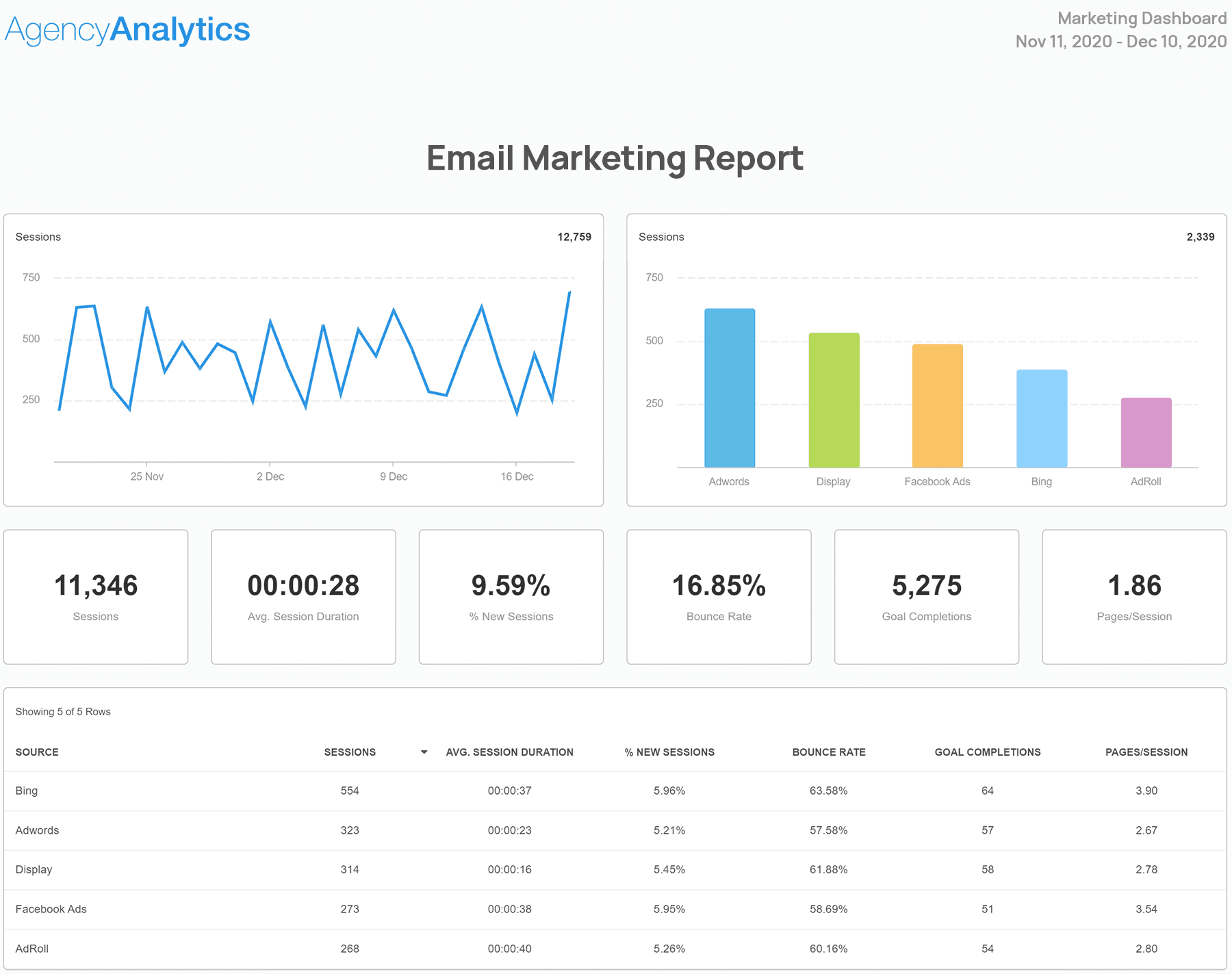
7. Web analytics report example — best for understanding on-site behavior and user journeys
A web analytics report offers a deep dive into how users interact with your client’s website. It helps uncover what’s working, where users drop off, and how to improve the site experience to boost conversions. A web marketing analytics report is a great fit for ongoing UX or CRO projects.
Key metrics to include in a web analytics report:
Traffic Overview
Total sessions
Unique visitors
New vs. returning users
Sessions by device (desktop, mobile, tablet)
Traffic by channel (organic, paid, referral, direct, etc.)
User Behavior
Average session duration
Bounce rate
Pages per session
Scroll depth
Exit rate
Top Pages & Navigation
Top landing pages
Top exit pages
Pageviews per page
Conversion rate by page
Internal site search queries
Conversion Metrics
Goal completions
Conversion rate
Funnel drop-off points
Revenue from conversions (if ecommerce)
Events triggered (e.g., button clicks, form submissions)
Site Performance
Page load time
Site speed by device or browser
Mobile vs. desktop performance
404 errors or broken links
Agency Tip: Group your data into traffic sources, on-site behavior, and conversion actions. That way, you show who’s visiting and what they’re doing once they arrive.
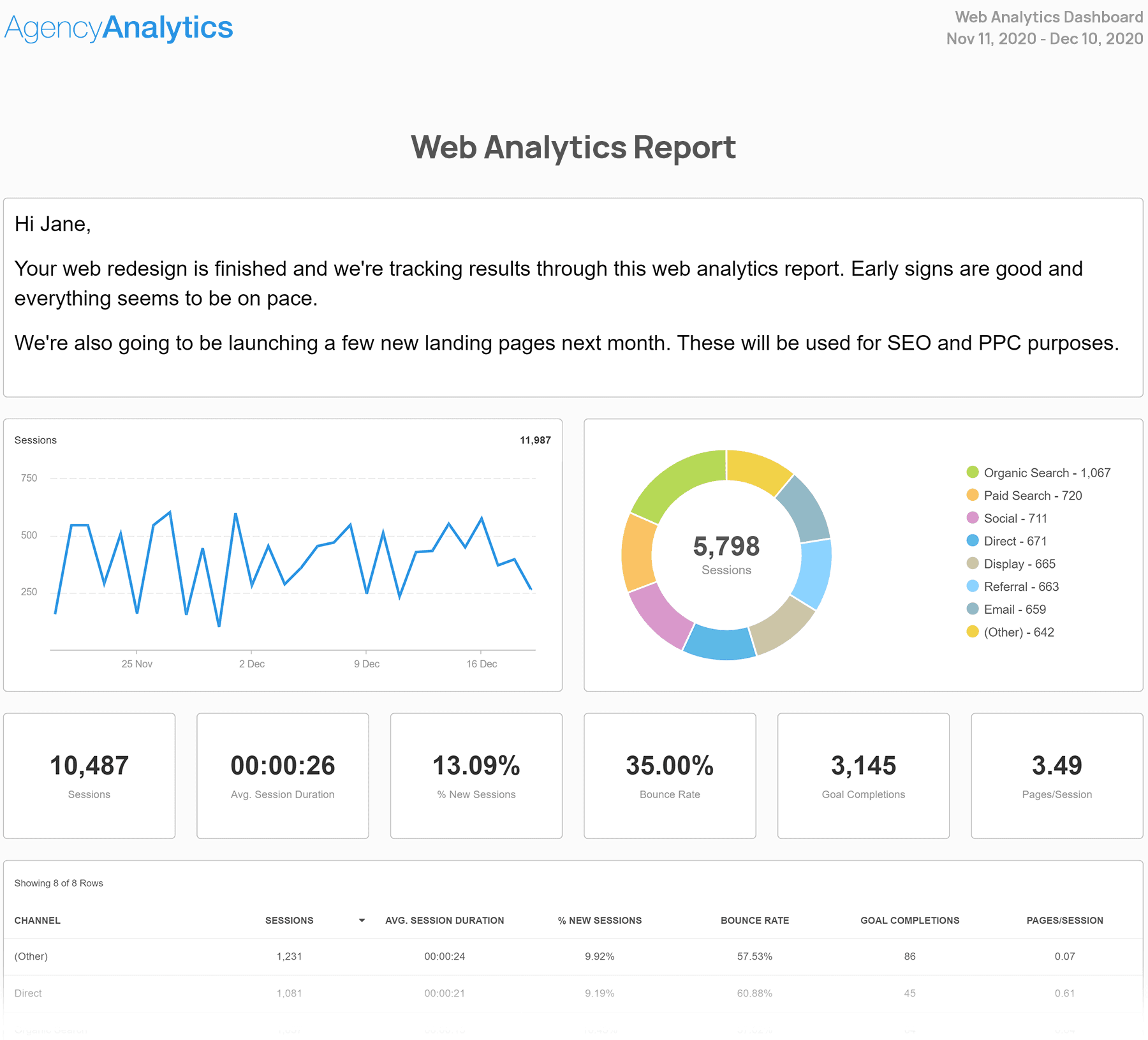
8. Ecommerce report example — best for tracking sales trends and revenue performance
Ecommerce clients live and breathe revenue. An ecommerce marketing report tracks everything from online sales to customer behavior, helping you fine-tune campaigns and boost ROI. It’s perfect for showing how marketing and UX improvements drive purchases.
Key metrics to include in an ecommerce marketing report:
Sales Performance
Total orders
Ecommerce conversion rate
Revenue by product or category
Customer Behavior
Add-to-cart rate
Checkout abandonment rate
Product views
Top-selling products
Traffic & Acquisition
Traffic by channel (organic, paid, email, referral, etc.)
New vs. returning customers
Traffic by device
Source/medium performance
Sessions to purchase
Customer Value & Retention
Repeat purchase rate
Time between purchases
First-time vs. returning customer revenue
Subscriber or loyalty program growth
Paid Advertising Metrics
ROAS
Cost per acquisition (CPA)
Ad impressions and clicks
Conversion rate from paid campaigns
Revenue from paid traffic
Agency Tip: Pair revenue data with traffic sources and product performance to show where sales are coming from and what’s selling best. Highlight repeat purchase trends to show long-term value.
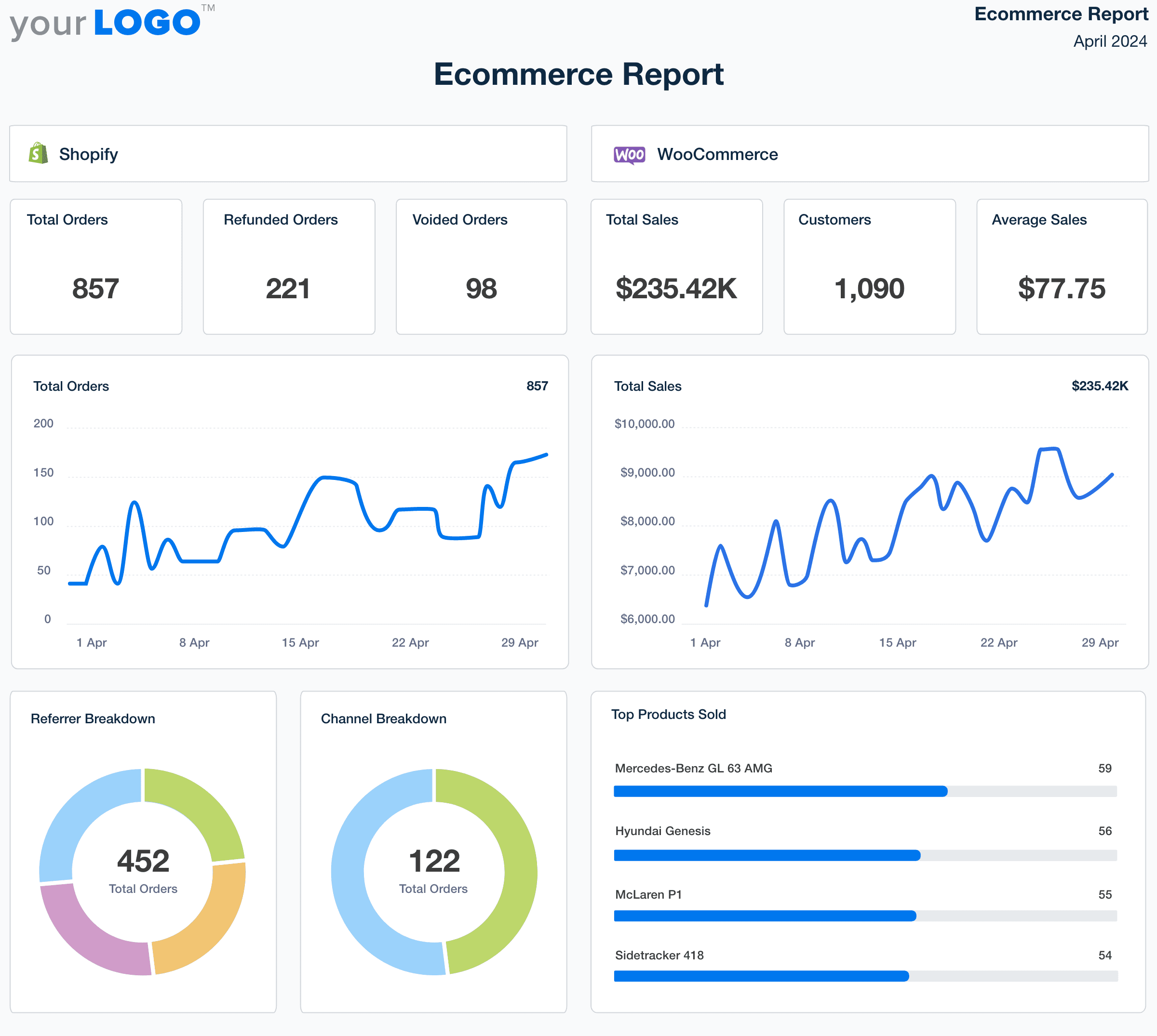
How to present client marketing data
When presenting key performance indicators (KPIs), the goal is to make insights clear, actionable, and easy to digest. Here’s how to streamline your reporting workflow and build a good marketing report clients can understand:
Start with a template
Use pre-built marketing report templates to get a head start. They include all the essentials, but you can tweak them to fit each client’s priorities—so no more building from scratch every time!
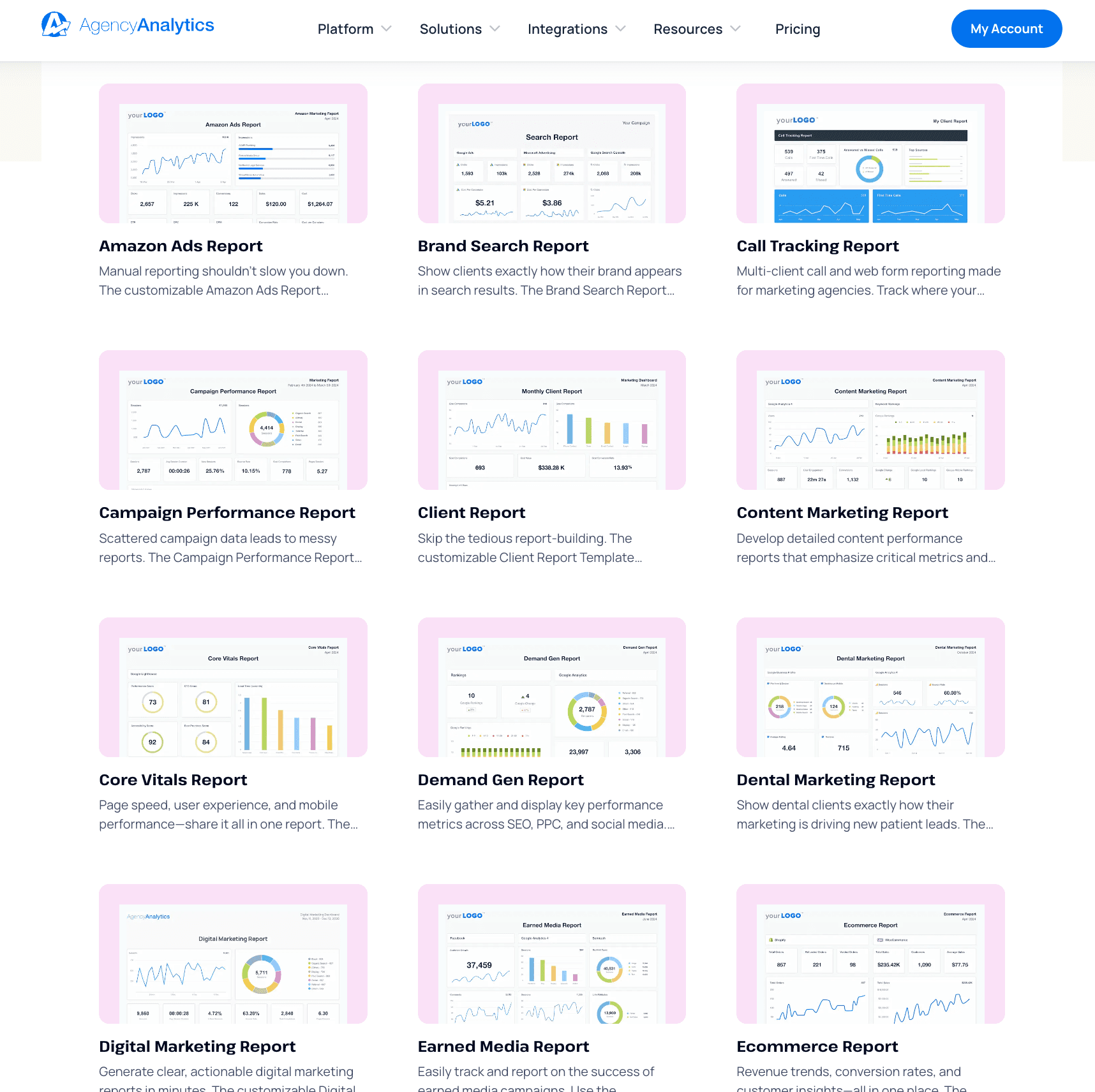
Customize for clarity
Highlight the KPIs that matter to each client. For some, that might be ROAS and conversions; for others, those marketing results could be organic traffic or engagement rates. A tailored report shows you’re paying attention to their unique business goals.
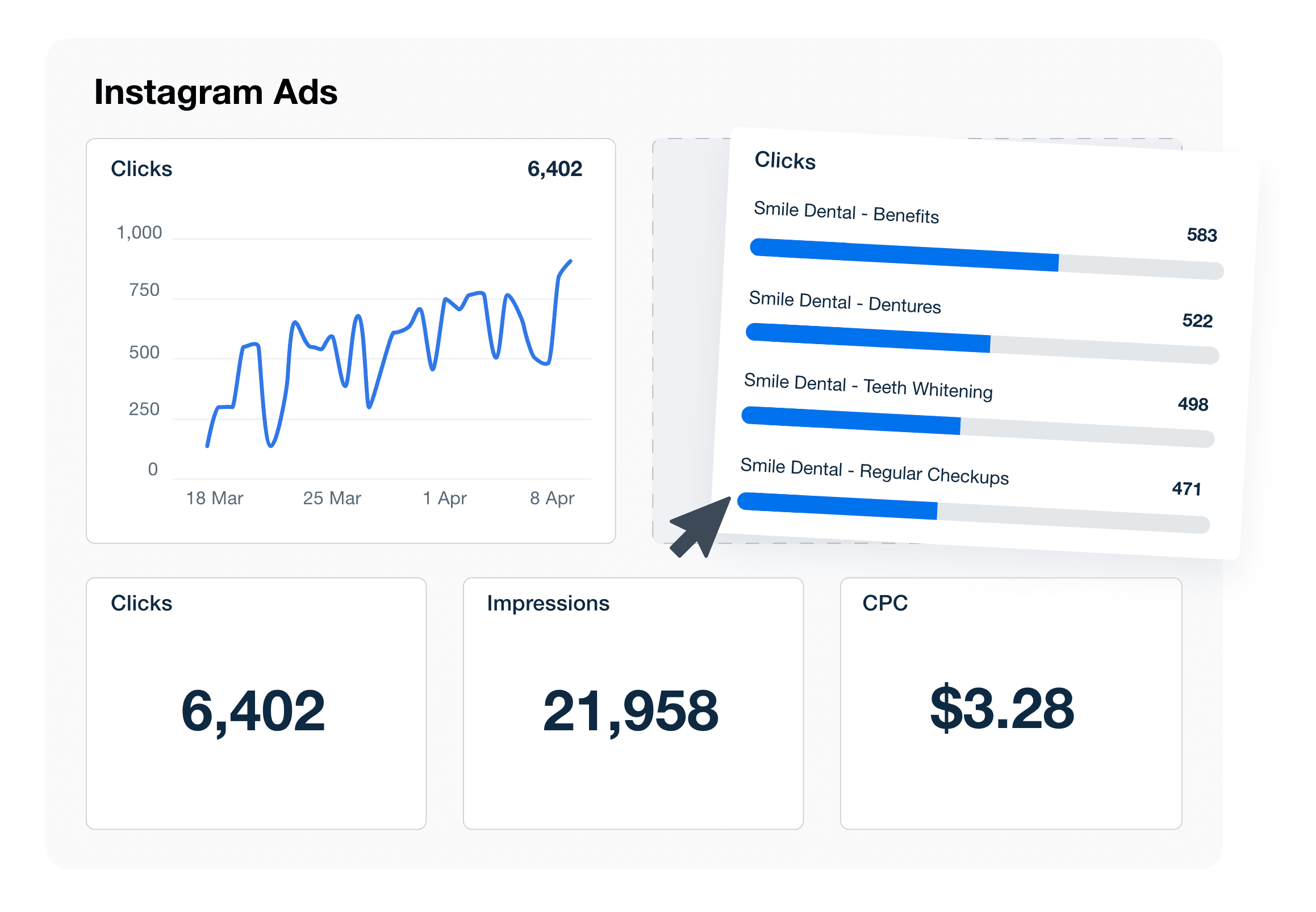
Include a report summary
Don’t just drop data; give it context. Add a short, plain-language summary at the top of each report to highlight key takeaways, wins, and next steps—especially if unexpected events or changes have affected marketing results.
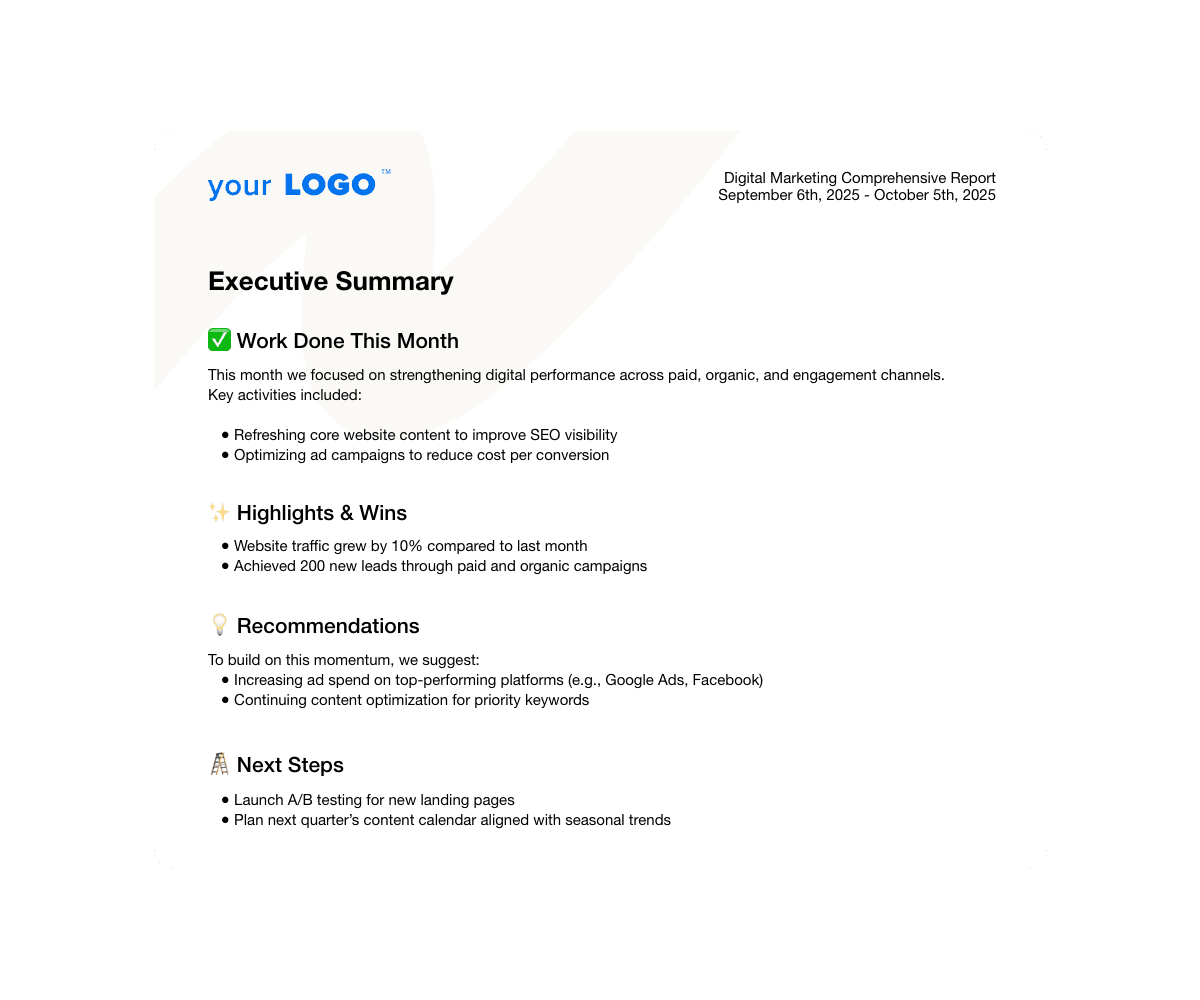
Use data visualizations
For an effective marketing report, use data visualizations like graphs, bar charts, and trend lines to make your insights pop! A visual cue helps clients understand the story behind the numbers faster without sifting through spreadsheets.
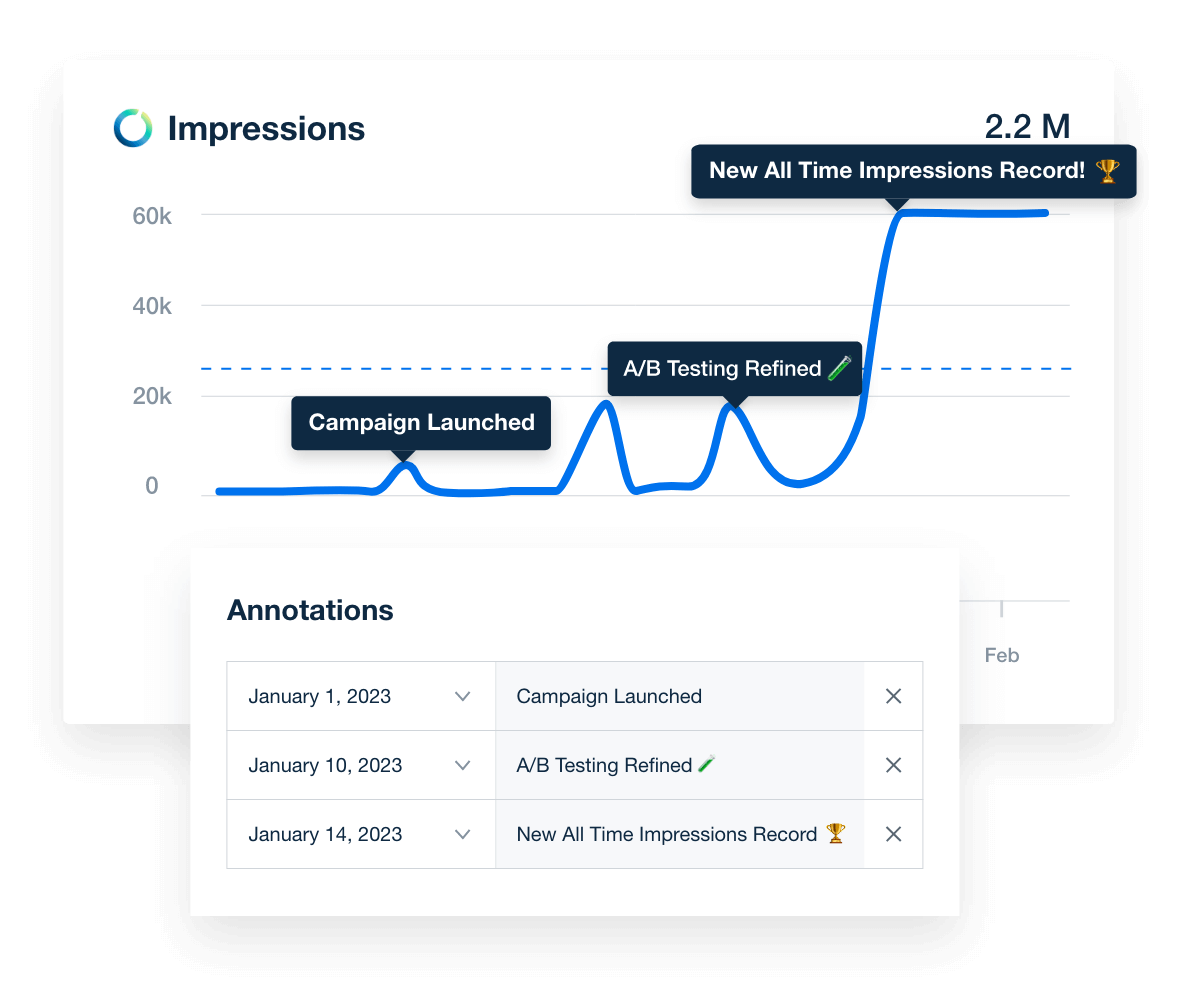
Set up automated reports
Schedule reports to be sent automatically on a weekly or monthly basis. This keeps clients in the loop without the last-minute scramble on your end. Bonus: it builds consistency and reinforces your agency’s reliability.
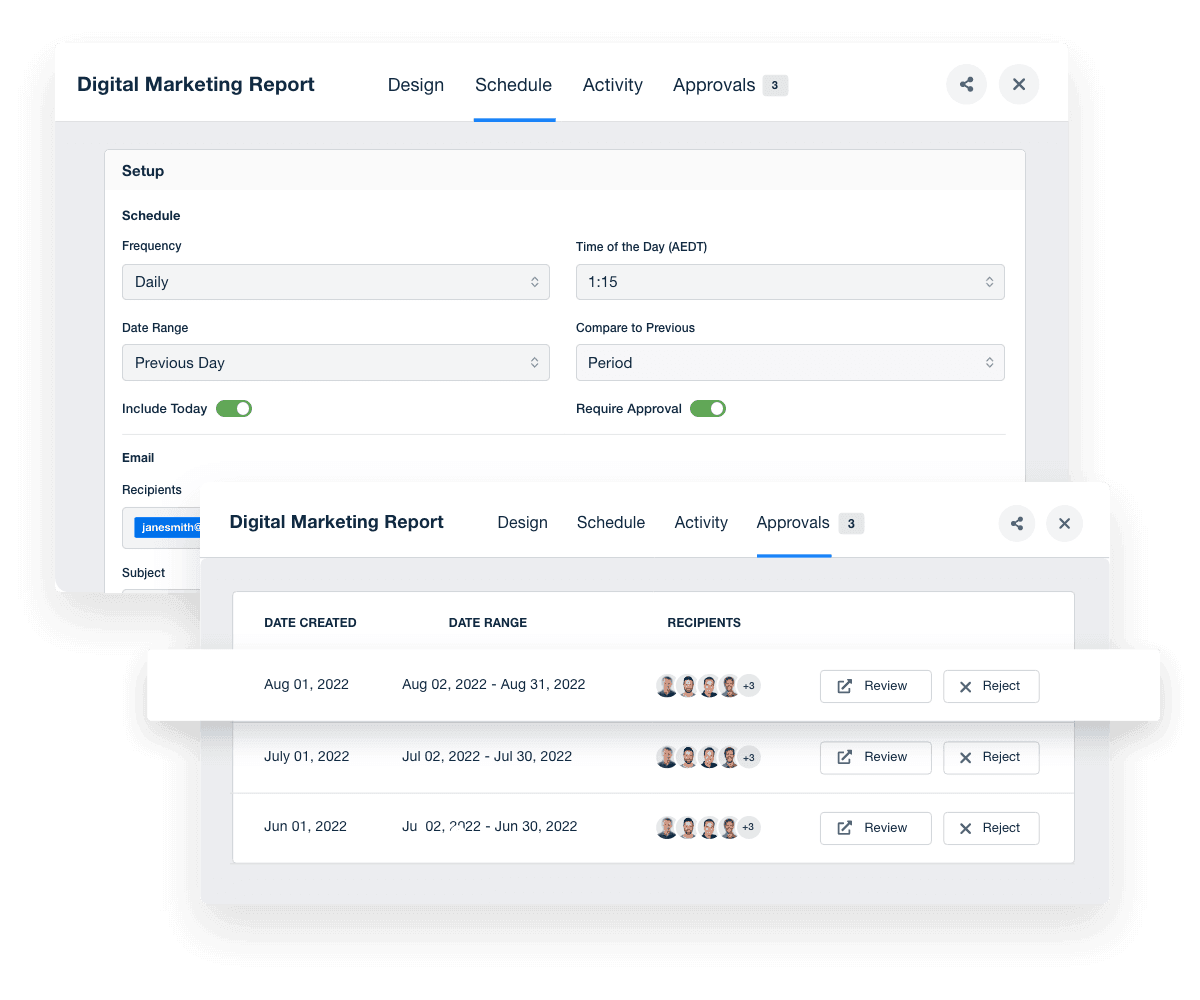
Add Your Agency’s Branding
White label your reports with your agency’s logo, colors, and even a custom domain. It’s a small touch that reinforces professionalism and trust.

When done right, reporting becomes a tool for better conversations—not just a status update.
How to build marketing dashboards that support your internal strategy AND client reporting
Marketing dashboards and client reports serve different purposes—but when they work together, they create a complete view of performance across all your marketing activities. Dashboards give your team real-time insights to monitor trends, spot issues early, and optimize campaigns faster. Reports translate those insights into clear narratives clients understand.
To build an internal dashboard that supports both your team and your client reporting process, start with your client’s business objectives.
If the goal is customer acquisition, surface performance metrics like CAC, qualified leads, customer lifetime value, and landing page conversion rate. If the priority is improving audience engagement, highlight page views, click-through rate, brand mentions, and performance trends across social media platforms.
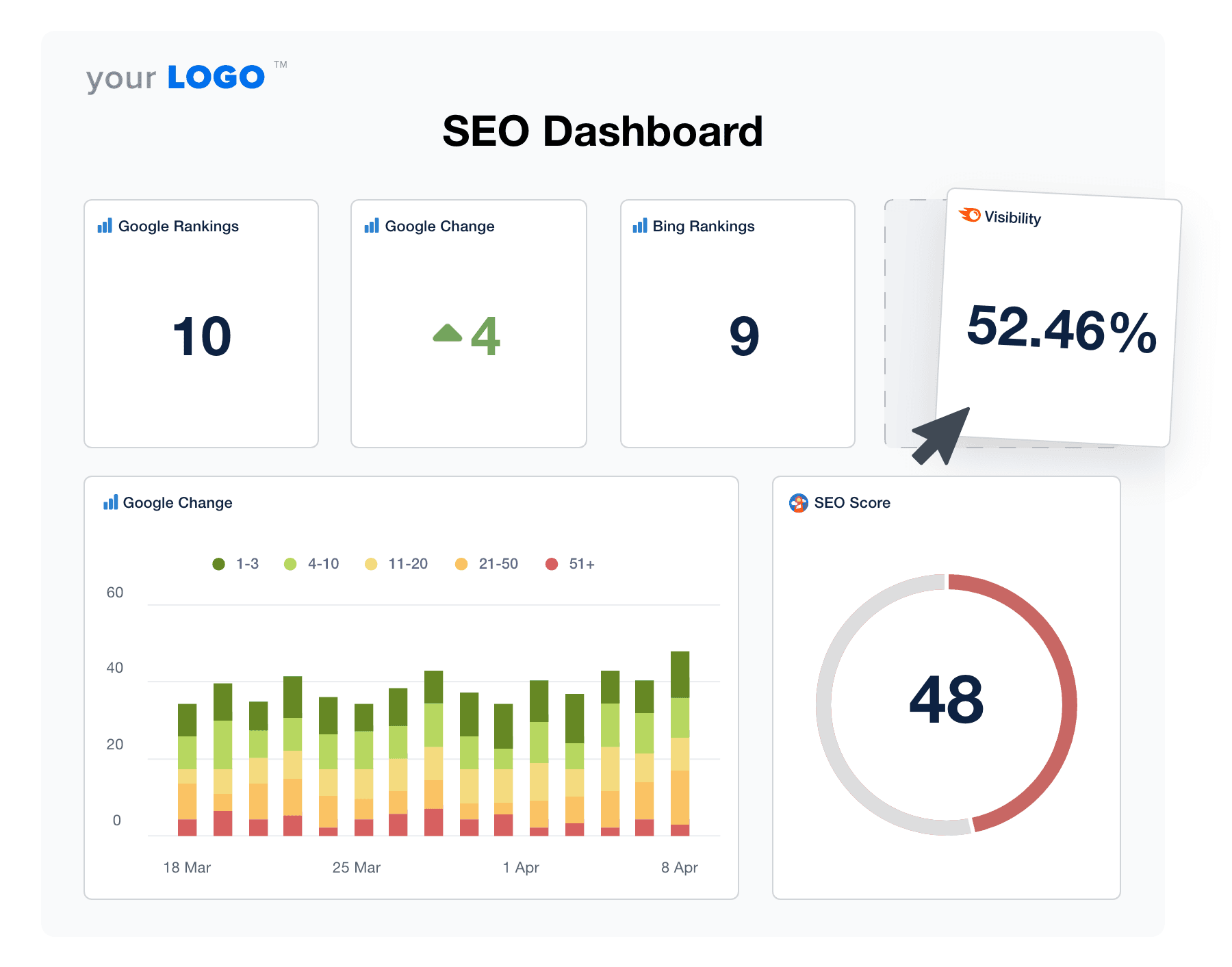
A great marketing analytics dashboard organizes relevant data from multiple sources—SEO platforms, ad platforms, CRM systems, social media platforms, and website analytics—into one central hub. This makes it easy to segment data by date range, compare performance across campaigns, and pull the exact insights you need for weekly reports, monthly summaries, and quarterly strategy reviews. It also ensures your team works with reliable data, which reduces human error and creates operational efficiency.
Dashboards give your team a holistic view of campaign strategies while letting you dig deeper into granular insights. You’ll see which channels drive the most traffic, which ads deliver the highest return on investment, and which pages convert new users into qualified leads. With historical data layered in, your team gains a better understanding of long-term performance trends and can make accurate forecasts for future performance.
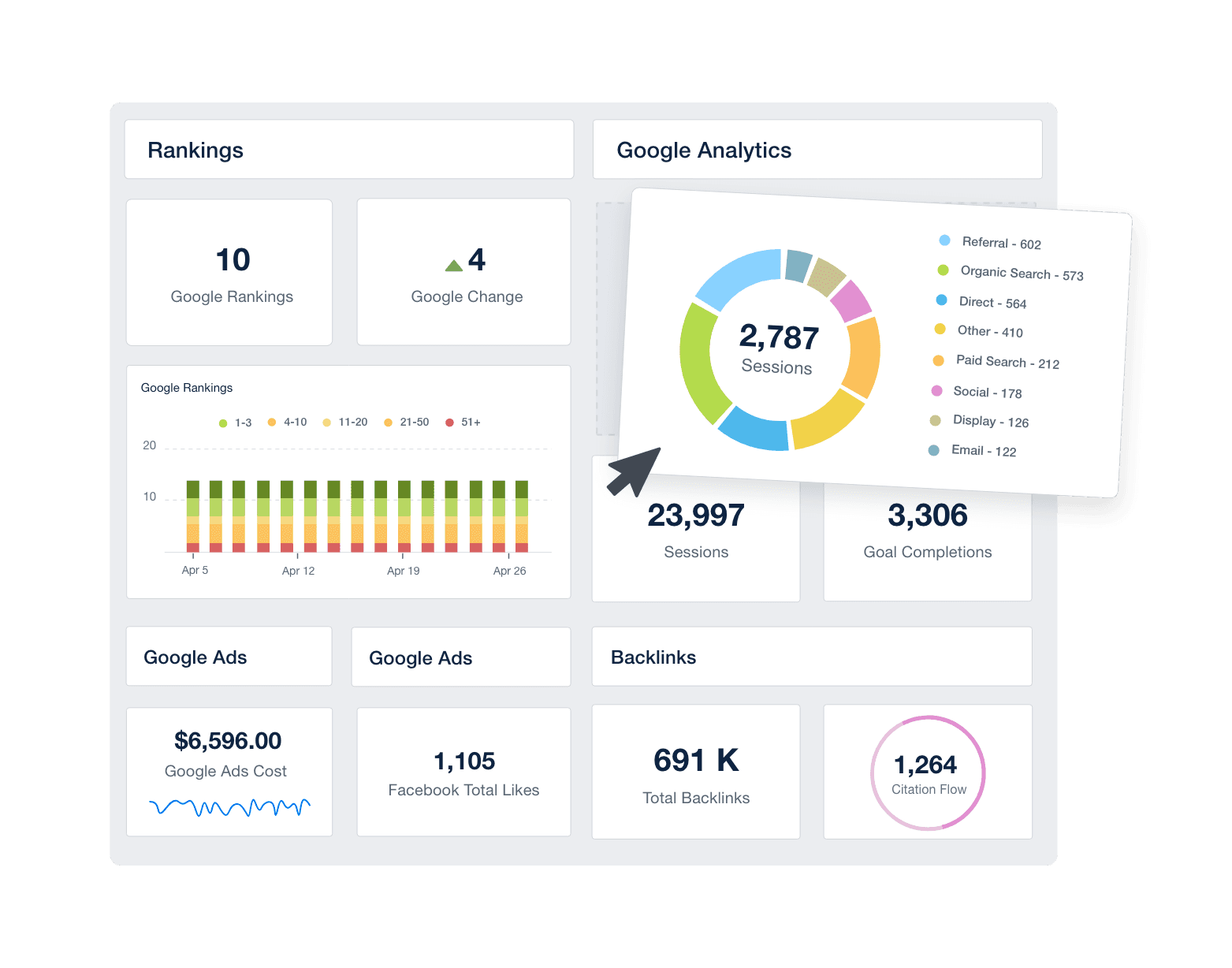
When it’s time to create a marketing report for clients, your dashboard becomes the foundation. You already have the complete overview, high-level metrics, and detailed analysis in one place. That means your team member can build reports faster, keep the reporting process consistent, and deliver polished visual summaries that speak directly to business impact. Clear visuals, segmented data, and key insights make it easier for clients to make informed decisions—and they reinforce your agency’s value.
AgencyAnalytics brings this dual usage to life. Internal teams use dashboards to monitor trends, optimize strategies, and track progress across various marketing channels. Then, with a few clicks, they turn that data into automated, client-ready reports that highlight the most relevant metrics for each audience type. With dashboard templates, 80+ integrations, real-time insights, and a drag-and-drop builder, your agency gets one seamless workflow instead of juggling multiple platforms or exporting data sets manually.
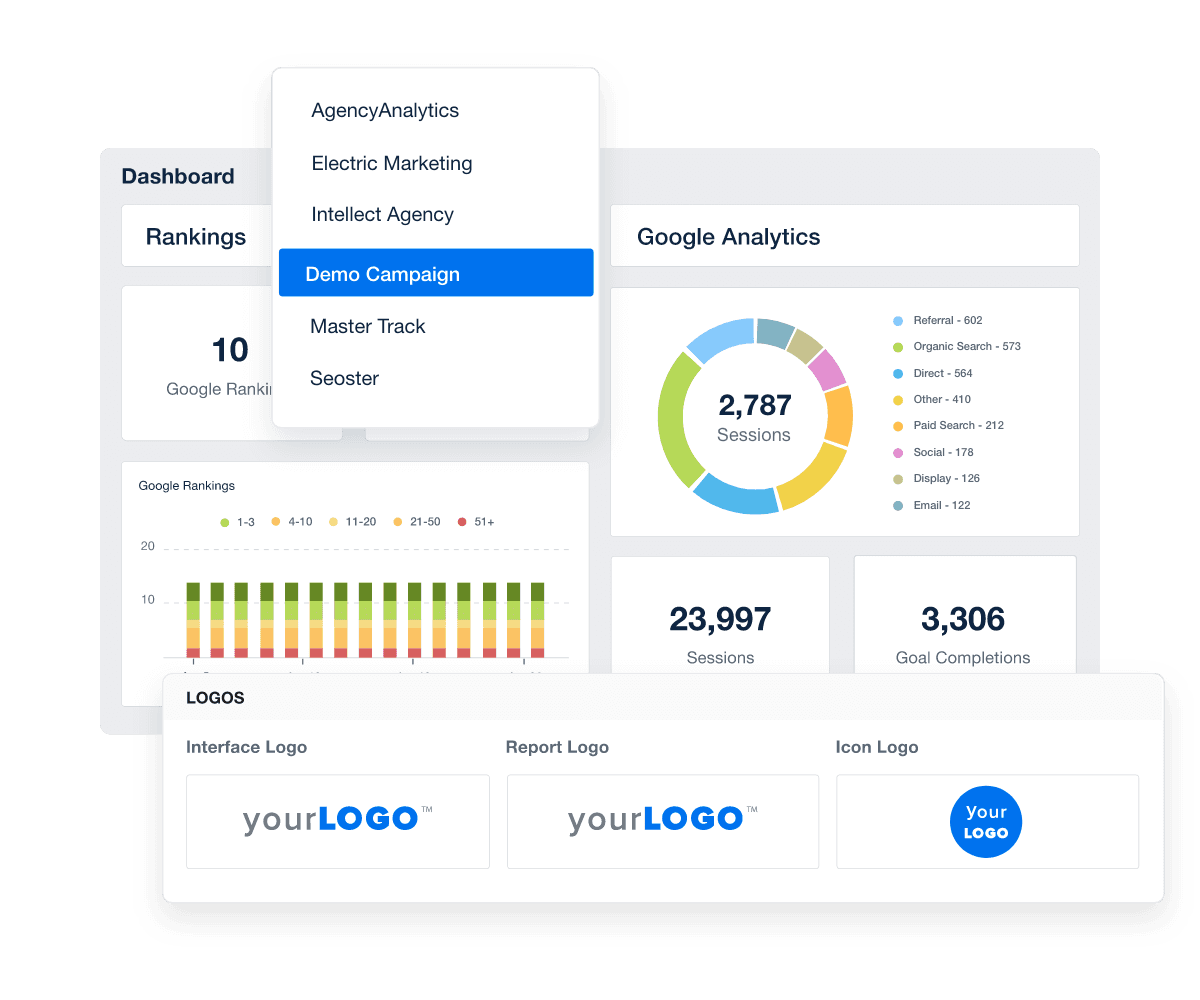
Why use AgencyAnalytics for client reporting?
You’ve got the strategy. You’ve got the data. Now you just need a fast, reliable way to turn it into client-ready reports.
That’s precisely what AgencyAnalytics was built for.
Our platform is purpose-built for marketing agencies that need to scale their reporting without burning out their team. Whether you're managing 5 or 50 clients, we help you automate the entire process—from pulling in performance data to sending polished reports that wow clients.
Here’s how we make reporting effortless:
Customizable Templates: Start with professionally designed templates for SEO, PPC, social, email, ecommerce, and more—or create your own from scratch.
Smart Reports: Need a template that wasn’t included in our list? Don’t fret. Use Smart Reports to automatically generate reports based on your client’s specific connected integrations. You’ll get a ready-to-go layout in under 11 seconds.
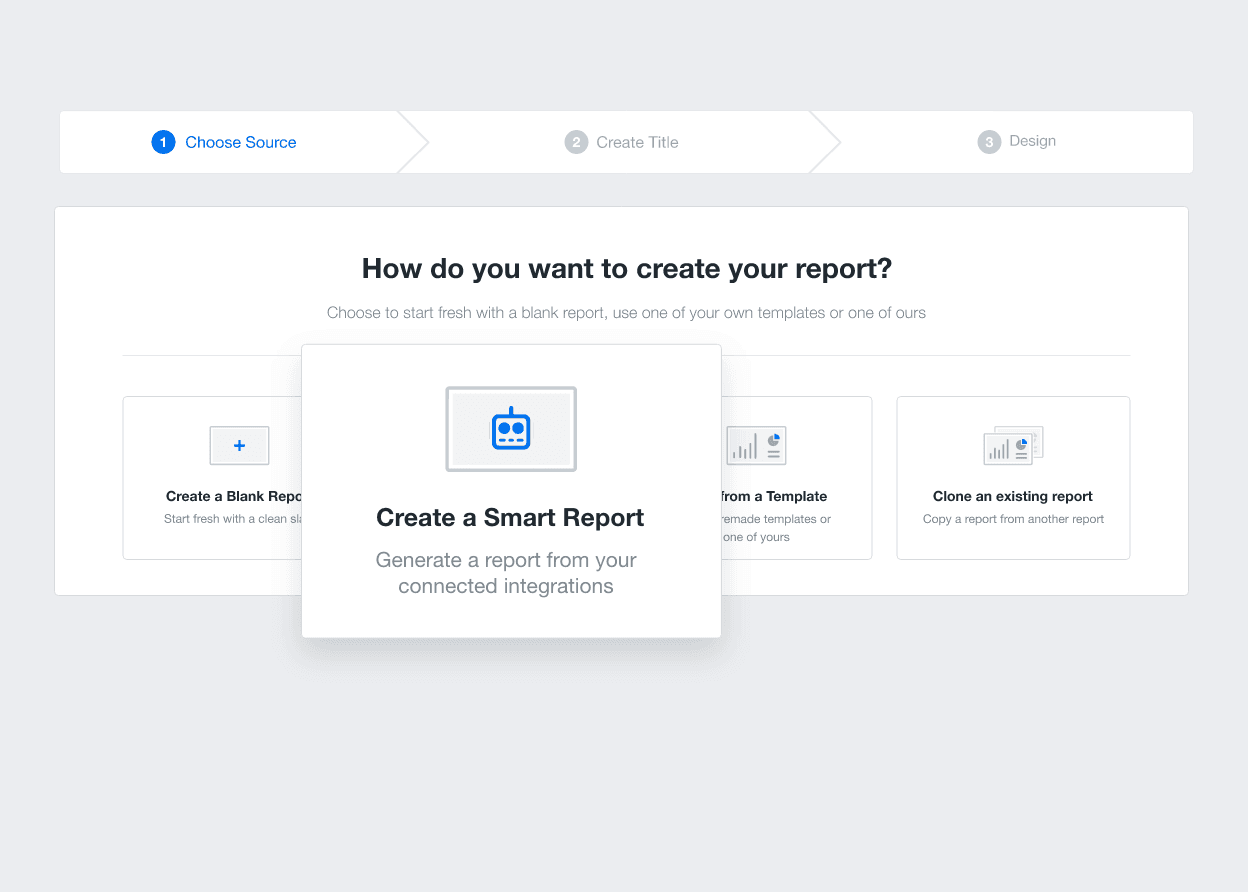
80+ Marketing Tool Integrations: Connect to platforms like Google Analytics, Facebook Ads, Shopify, HubSpot, and more in seconds.
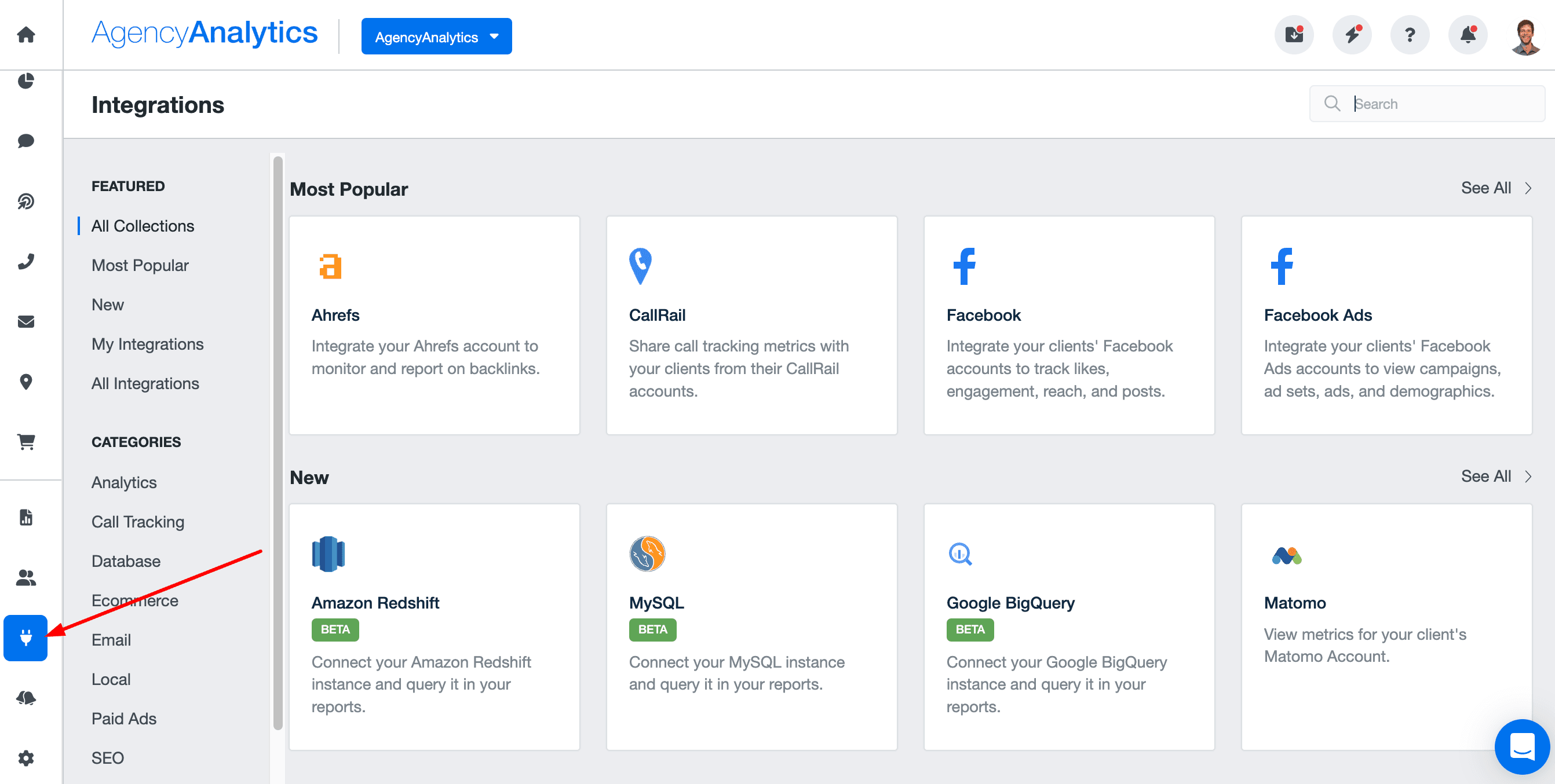
Drag-and-Drop Report Builder: Easily rearrange widgets, highlight priority KPIs, and add your agency’s recommendations—no design skills needed.
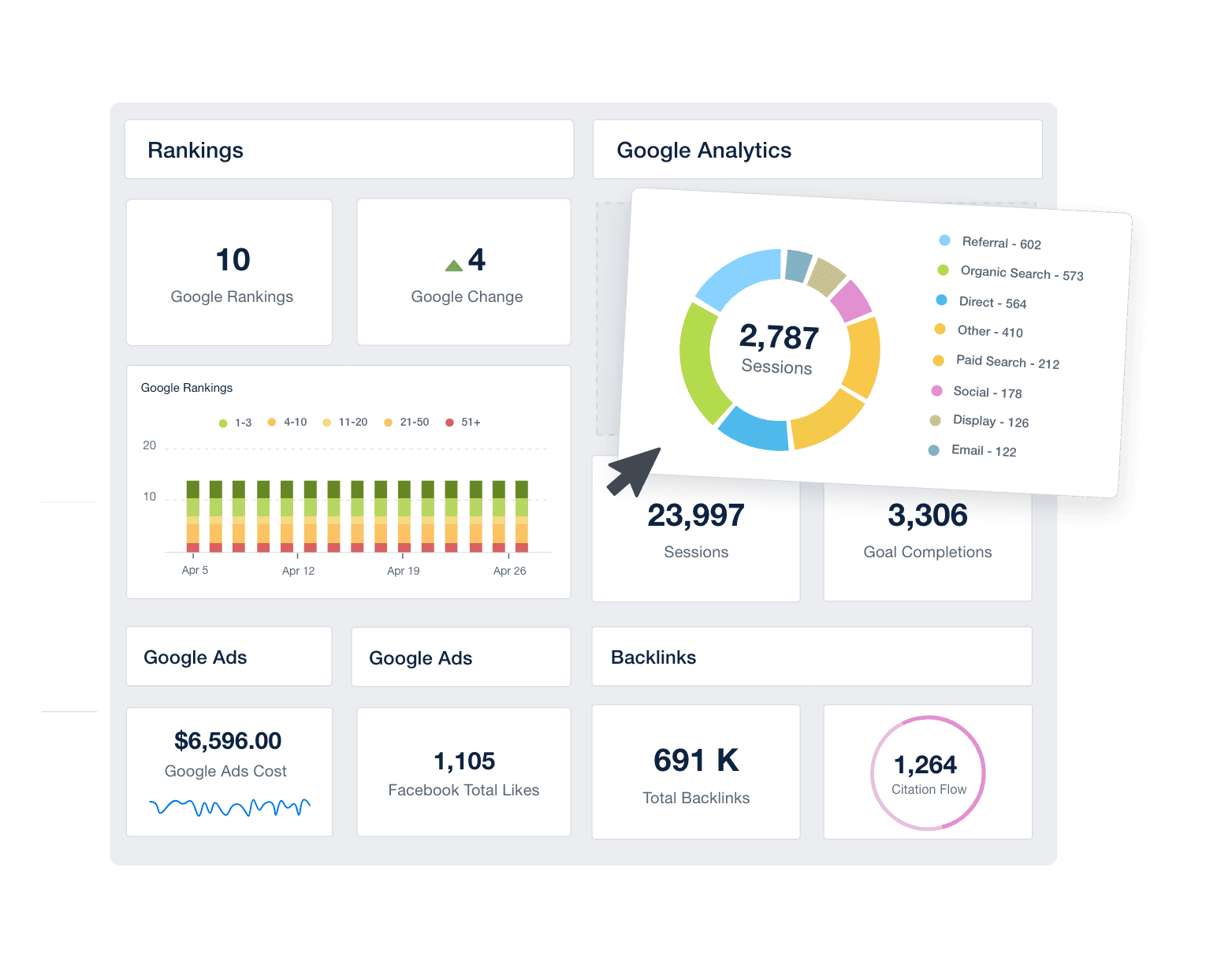
Real-Time Dashboards: With live dashboards, clients have 24/7 access to their data—no more scrambling to answer last-minute questions.
Automated Delivery: Set it and forget it. Schedule reports to go out weekly, monthly, or on your client’s preferred timeline.

White Labeled Reports: Add your logo, colors, and even use a custom domain—so every report looks like it came directly from your agency.
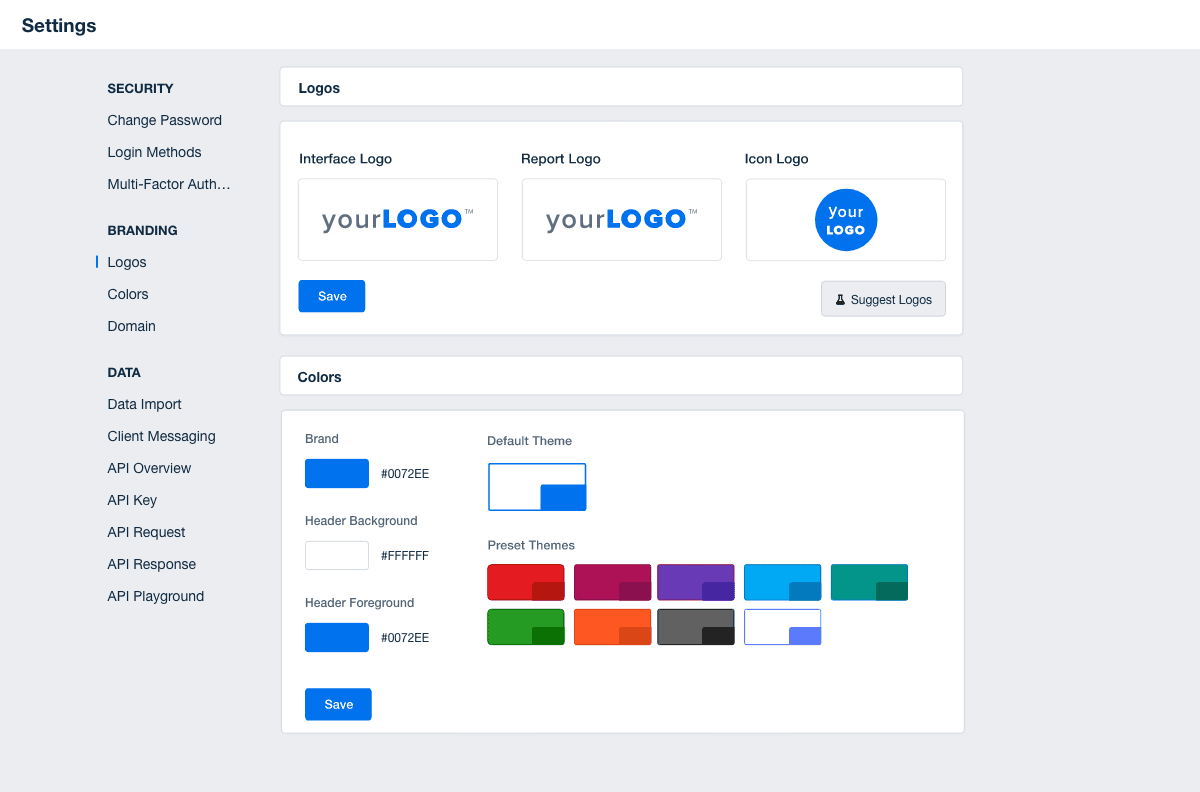
AI-Powered Insights: Let our AI do the heavy lifting. Automatically surface key trends, anomalies, and performance highlights—so you can deliver smarter insights to clients faster without digging through every data point.
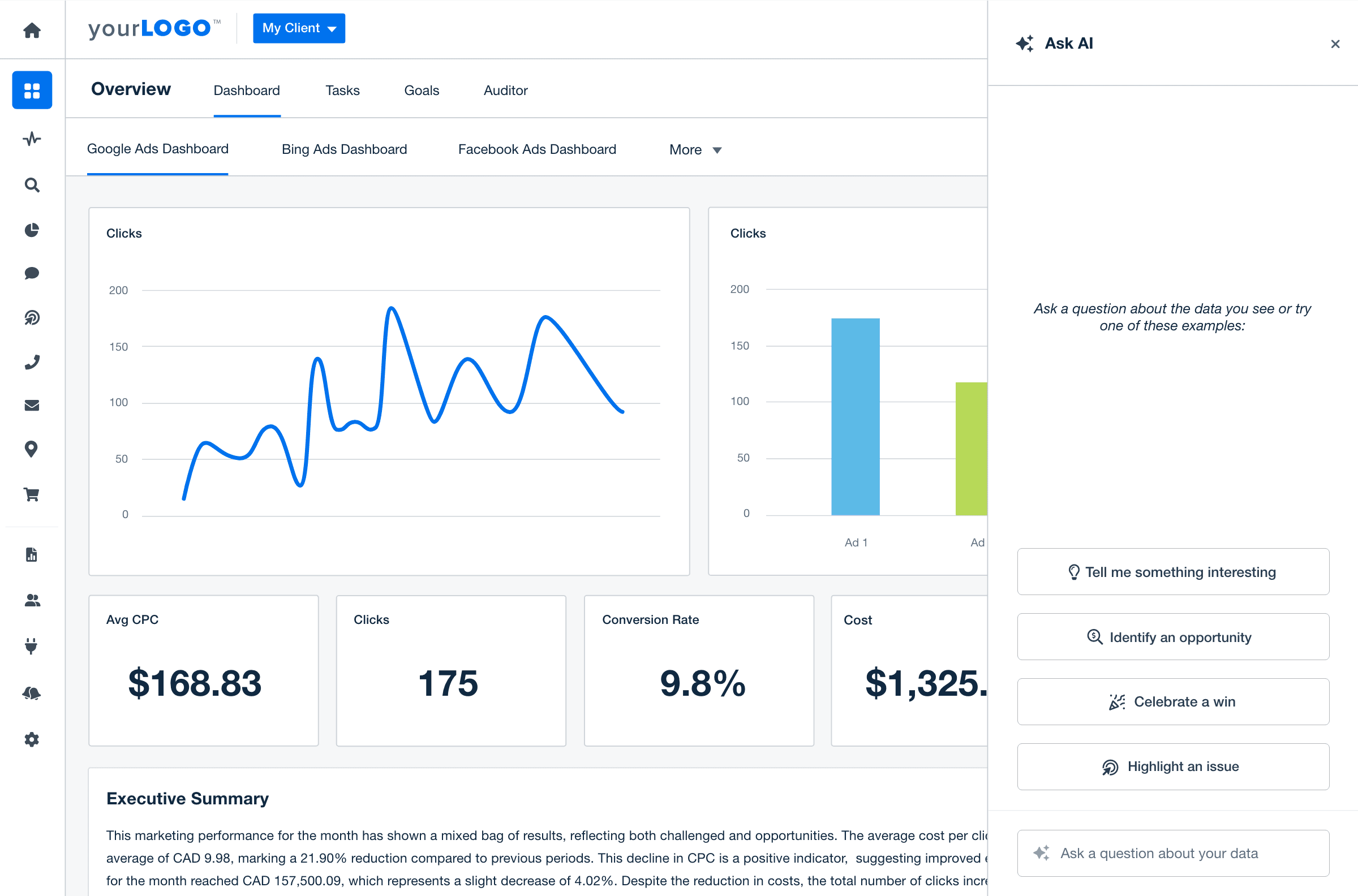
It’s time to automate marketing reporting
You’ve seen how much time templates can save. Now imagine what your agency could do with all that time back!
Instead of chasing screenshots, stitching together data, or formatting another spreadsheet, you could be:
Crafting stronger strategies.
Having more meaningful conversations with clients.
Growing your agency.
With AgencyAnalytics, you get a complete reporting system customized, automated, and client-ready in minutes. From Smart Reports and AI-powered insights to 80+ integrations and real-time dashboards, it’s everything your agency needs to deliver polished reports without the manual headache.
Getting started is easy:
Connect Multiple Data Sources: Choose from 80+ built-in integrations.
Pick a Report Template: Start with one of the 8 in this post.
Customize the Layout: Highlight your client’s most important KPIs.
Schedule Delivery: Set reports to send weekly or monthly.
Sit Back: We’ll handle the rest.
Start your free 14-day trial and create your first automated client report in under 11 seconds.
Frequently asked questions about marketing report examples and templates
Still have questions about building client reports using marketing report examples and templates? We’ve got you covered!

Written by
Sylva is an expert content writer with over 10 years of experience in tech and SaaS, offering first-hand insight into agency needs from her background in advertising.
Read more posts by Sylva SivzattianSee how 7,000+ marketing agencies help clients win
Free 14-day trial. No credit card required.



